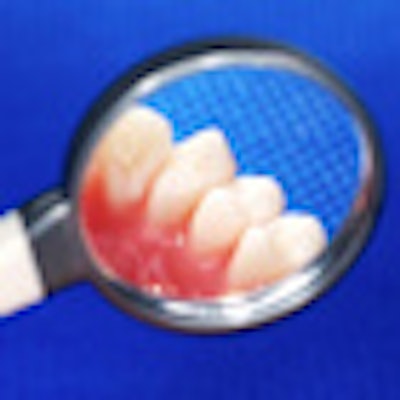
One out of every two American adults age 30 or older has periodontal disease, according to a new study published in the Journal of Dental Research.
The findings were collected as part of the U.S. Centers for Disease Control and Prevention's (CDC) 2009-2010 National Health and Nutrition Examination Survey (NHANES), a program of studies designed to assess the health and nutritional status of adults and children in the U.S.
The data indicate that 47.2%, or 64.7 million American adults, have some form of periodontal disease. In adults older than age 65, prevalence rates increase to 70.1%.
The 2009-2010 survey included, for the first time, a full-mouth periodontal examination. Previous NHANES estimates of periodontal disease relied on partial mouth periodontal examination (PMPE) protocols that collected measurements from two randomly selected quadrants of the mouth and assessed probing depth and attachment loss at two sites per tooth.
More comprehensive assessment
Because periodontal disease is not evenly distributed in the mouth, prevalence estimates from surveys using PMPE protocols may have underestimated the severity of the disease within the U.S. population by as much as 50%, the American Academy of Periodontology (AAP) noted in a press release. The 2009-2010 NHANES survey collected measurements from six sites per tooth for all teeth (except third molars) in U.S. adults.
The AAP has been working closely with the CDC since 2003 to determine the extent, severity, and prevalence of periodontal disease in the U.S.
“This is the most accurate picture of periodontal disease in the U.S. adult population we have ever had.”
— Pamela McClain, DDS, president, American Academy of Periodontology
"We know that periodontal disease can be very site-specific, so unless you look at the entire mouth and assess each tooth, you could miss severe disease," Pamela McClain, DDS, president of the American Academy of Periodontology (AAP) and a practicing periodontist in Aurora, CO, told DrBicuspid.com. "Unless you are doing a comprehensive exam where you are probing at least six sites on every tooth, you are not getting an accurate picture of that patient's periodontal health."
The AAP collaborated with the CDC to help the agency develop a more accurate assessment of periodontal disease, she added.
"We now have a precise measure of the prevalence of periodontal disease and can better understand the true severity and extent of periodontal disease in our country," Dr. McClain said. "This is the most accurate picture of periodontal disease in the U.S. adult population we have ever had."
Disparities among certain populations
The data in the JDR study indicate prevalence disparities among certain segments of the U.S. population. Periodontal disease is higher in men than women (56.4% versus 38.4%) and is highest in Mexican-Americans (66.7%) compared with other races. Other segments with high prevalence rates include current smokers (64.2%); those living below the federal poverty level (65.4%); and those with less than a high school education (66.9%).
"We have demonstrated a high burden of periodontal disease in the adult U.S. population, especially among adults 65 and older," said lead study author Paul Eke, MPH, PhD, a CDC epidemiologist, in an AAP press release. "Periodontal disease is associated with age, and as Americans live longer and retain more of their natural teeth, periodontal disease may take on more prominence in the oral health of the U.S adult population."
Co-author Robert Genco, DDS, PhD, a distinguished professor at the State University of New York at Buffalo and past president of the American Association for Dental Research and the International Association for Dental Research, believes these findings elevate periodontal disease as a public health concern.
"We now know that periodontal disease is one of the most prevalent noncommunicable chronic diseases in our population, similar to cardiovascular disease and diabetes," he said.
The 2009-2010 NHANES periodontal disease data support the need for comprehensive periodontal evaluations performed annually by a member of the dental team, including a dentist, dental hygienist, or periodontist, Dr. McClain added. This includes examining every tooth and measuring both attachment loss and probing depth to get the most accurate assessment of periodontal disease.
"Many of our patients have periodontal disease and do not know it," she stated. "As dental professionals, it is more important than ever that we provide patients with a comprehensive periodontal evaluation annually to determine their disease status."



















